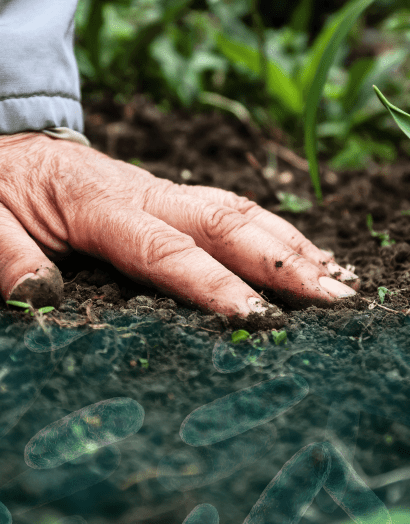Prebiotics, probiotics and postbiotics: guide to soil health
These are terms we use in human health, but their application in agriculture is equally relevant. We explain what they are, how they differ, and why their use in agriculture is transforming soil microbiome health.
The rhizosphere is the thin layer of soil surrounding the roots and has become the epicenter of modern agricultural research. This is where plants and microorganisms exchange chemical signals, nutrients, and mutual favors in what scientists call the "second genome" of plants.
A silent revolution is occurring beneath our feet: soil microbiome science is demonstrating that the same principles that benefit our gut health can radically transform the way we grow our food.
The hidden universe beneath the surface
Every gram of healthy soil harbors billions of microorganisms: bacteria, fungi, actinomycetes, and archaea that form a complex and interdependent ecosystem. This microbiome is not a mere spectator in plant life; it is an active collaborator, an invisible ally that can make the difference between a resilient crop and a vulnerable one.
The combination of prebiotics, probiotics, and postbiotics can generate results greater than the sum of their parts. Prebiotics feed probiotics, which in turn produce postbiotics, creating a virtuous cycle of continuous improvement of the soil microbiome.

Differences between prebiotics, probiotics, and postbiotics
Three concepts, one mission.
Prebiotics: preparing the ground
Prebiotics are compounds that feed and promote beneficial microorganisms, creating the perfect conditions for them to thrive.
- Unlike conventional fertilizers, which directly nourish the plant, prebiotics adopt a more strategic approach.
- L-alpha-amino acids, for example, act as a preferred source of carbon and nitrogen for beneficial soil bacteria.
- By strengthening these microbial communities, we indirectly improve the plant's ability to absorb nutrients, resist diseases, and tolerate stress.
Probiotics: the beneficial colonizers
If prebiotics prepare the ground, probiotics are the protagonists of the story. These are living microorganisms that, when introduced into the soil or plants, generate tangible and measurable benefits.
One well-studied example is Bacillus velezensis PH023, a bacterium that has demonstrated extraordinary properties. This strain not only effectively colonizes the root environment, establishing its territory against potential pathogenic invaders, but also acts as a kind of "biochemical factory" producing natural phytohormones that stimulate plant growth.
But its contribution goes further. Soil probiotics can:
- Solubilize blocked nutrients, releasing phosphorus, iron, and other elements that, although present in the soil, are in forms that plants cannot utilize.
- Compete with pathogens for space and resources, acting as a natural biological shield.
- Produce compounds that strengthen plant defenses, preparing them to respond better to future attacks.
It's like having a team of microscopic workers constantly improving the living conditions of your crops.
Postbiotics: the functional legacy
This is where the story becomes truly fascinating. Postbiotics represent the next level of sophistication in plant biostimulation. They are not living microorganisms, but metabolites and bioactive compounds that these produce during their growth.
Think of them as the molecular "fingerprints" left behind by probiotics: organic acids that modify soil pH, plant hormone precursors, enzymes that break down organic matter, bioactive peptides that activate defensive responses in plants.
What's revolutionary about postbiotics is that they maintain their functionality beyond the viability of the microorganism. This confers significant practical advantages: greater stability during storage, lower sensitivity to adverse environmental conditions, and more predictable and standardizable effects.
Advantages of postbiotics:
- Improve nutrient bioavailability in soil
- Stimulate plants' innate defense mechanisms
- Modulate the balance between different microbial groups
- Reduce oxidative damage caused by environmental stress
It proposes a different model: working with nature, not against it. Nourishing the soil so it can nourish the plants. Cultivating robust microbial ecosystems that provide ecological services naturally and renewably.

The synergy that multiplies results
What is truly innovative in 21st-century agriculture is understanding that these three concepts do not work in isolation, but synergistically. It's like an orchestra where each section complements and enhances the others.
An integrated approach that combines prebiotics, probiotics, and postbiotics can generate results greater than the sum of their parts. Prebiotics feed probiotics, which in turn produce postbiotics, creating a virtuous cycle of continuous soil microbiome improvement.
The combination of prebiotics, probiotics, and postbiotics allows:
- Optimizing plant nutrition without relying exclusively on synthetic chemical fertilizers.
- Improving soil structure and its water retention capacity
- Increasing crop resilience to droughts, salinity, or extreme temperatures
- Reducing disease incidence through biological competition and activation of natural defenses
- Enhancing root development, allowing more efficient exploration of the soil profile
Toward regenerative agriculture
We are witnessing a paradigm shift in how we understand agriculture. During the 20th century, the dominant approach was to maximize production through external inputs: synthetic fertilizers, pesticides, intensive mechanization. The results were impressive in terms of productivity, but also generated long-term sustainability problems: soil degradation, groundwater contamination, biodiversity loss.
The new regenerative agriculture proposes a different model: working with nature, not against it. Nourishing the soil so it can nourish the plants. Cultivating robust microbial ecosystems that provide ecological services naturally and renewably.
The concepts of prebiotic, probiotic, and postbiotic are fundamental tools in this transition. They represent a more intelligent and sophisticated way of managing crops, based on a deep understanding of the biological interactions that sustain plant life.
In modern agriculture, increasingly oriented toward sustainability, the concepts of prebiotic, probiotic, and postbiotic are consolidating as key tools. Understanding their differences and their joint action is fundamental to designing more efficient management strategies that are respectful of the environment and show visible results in crop health and productivity.

The future is here: Terra-Sorb radicular SymBiotic®
An innovative way to integrate these three concepts into a single product is through Terra-Sorb radicular SymBiotic®. This advanced biostimulant has been designed to act synergistically, combining in a single solution the three types of "biotics":
- Prebiotic: the L-alpha-amino acids present in its formulation serve as highly bioavailable food for beneficial microorganisms.
- Probiotic: the incorporation of Bacillus velezensis strain PH023 provides a living microorganism with biofertilizing activity and plant growth promotion.
- Postbiotic: the metabolites derived from the microbial fermentation process offer bioactive effects on the plant, even in the absence of living organisms, providing stability and immediate functionality.
This holistic approach allows improving crop vitality, enhancing root development, increasing nutrient absorption efficiency, and preparing the plant to face stress conditions.
The soil microbiome revolution
In modern agriculture, increasingly oriented toward sustainability and soil microbiome optimization, the concepts of prebiotic, probiotic, and postbiotic are consolidating as key tools. Understanding their differences and their joint action is fundamental to designing more efficient management strategies that are respectful of the environment and show visible results in crop health and productivity.
Products like Terra-Sorb radicular SymBiotic® mark the path toward regenerative agriculture, where nourishing soil microorganisms is as important as nourishing the plant itself.
The next time we observe a cultivated field, it's worth remembering that the real action is happening in the invisible world beneath the surface, where billions of microorganisms work tirelessly to make every harvest possible. And now, at last, we are learning to be good stewards of that extraordinary ecosystem.
Scientific outreach article based on the latest advances in soil microbiology and plant biostimulation. The practical application of these concepts should always be carried out considering the specific conditions of each crop and region and under the technical supervision of a specialist.



